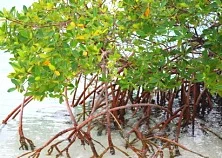Pulau Tioman has quite a few patches of mostly modestly-sized but extremely old mangrove forests. Tioman's mangroves include typical mangrove species like
Rhizophora apiculata,
Bruguiera gymnorhiza and
Excoecaria agallocha.
 Pulau Tulai's mangroves
Pulau Tulai's mangroves
The symbiotic relationship between Tioman's coral reefs and its mangrove forests is quite established with the crystal clear water around the Tioman area, which has through numerous surveys been shown to be home to an unusually large variety of fauna and flora.
Tioman Mangrove Diversity
A total of 23 mangrove species have been identified across Tioman and its sister island Pulau Tulai. Of these, 16 are exclusive species and 7 are non-exclusive. Furthermore, a recent hybrid species,
Rhizophora X lamarkii, has also been identified.
Tioman's Mangroves Locations
On Tioman itself, mangrove forest pockets can be found in Kampung Juara, Kampung Genting, Kampung Paya and Kampung
Nipah. In addition, Pulau Tulai (a.k.a. Coral Island or Mangrove Bay) located northwest of Tioman also offers thriving - and more diversely composed - mangrove forest areas.
 Tioman's Mangroves
Tioman's Mangroves
In fact, Tulai is one of the destinations around Tioman popular for their boat excursions to its coral gardens and mangrove forests. No eco-trips as such are undertaken to Tioman's native mangroves currently, but this may well change, as Tioman's operators learn about the mangroves' potential in education and conservation especially.
Tioman mangroves benefits
Mangroves typically generate a fair amount of valuable ecological and socioeconomic benefits to communities. However, people initially tend to be more focused on the financial gains, because the ecological value of mangroves is more intrinsic and not immediately identifiable. As a result of this, mangrove environments
are generally considered wasteland, as opposed to the highly prized ecosystem that they actually are.
In order to create both the communities' interest and understanding, providing income based on the ecological value of mangroves is critical. One way
in which this can be done is by means of developing and promoting ecotourism in and around Tioman's mangroves.
Clearly, through comprehensive planning and thorough consideration of the economic, environmental, as well as all cultural aspects, of mangrove ecotourism, ecotourism of this vital habitat
can play a major role not only in the contribution of conservation, education and resource protection, but also in the involvement of local communities, for example, by creating employment opportunities.
Use below form if you'd like to go on a mangrove ecotourism excursion

